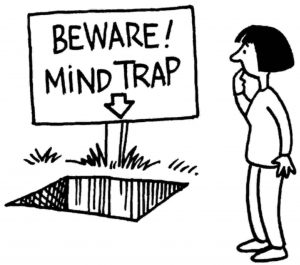Affordable Therapy in Guelph
After doing therapy in Guelph for 25 years I know cognitive therapy works.

Here is an example… We need to spend a little while to put our thoughts on the trial
Thoughts often do the twist in our mind!
We use the Thought Trial to figure out whether there is a difference between a thought, a feeling and a situation. Often they blend together and this is where the confusion comes from. We only want to believe truth, not half-truths. After all, the devil is known as the father of lies!
Do you:
– Think in absolutes: “always” or “never”, missing the in-between, the grey?
– View a negative event as a never-ending pattern of defeat?
Insist that your accomplishments or positive qualities don’t count (my college diploma was stroke of luck…really, it was)?
– Conclude things are bad without any definite evidence?
Mind-read? (Assume people react negatively to you)
– Fortune-tell? (Predict things will turn out badly).
– Reason from how you feel: “I feel like an idiot, so I must be one.”
– Criticize yourself or other people with “should,” “shouldn’ts,” “musts,” “oughts” and “have-tos?”
– Blame yourself for something you weren’t entirely responsible for?
– Blame others and overlook ways you contributed to a problem?
The following exercise will help you determine whether your thoughts are not true 100% of the time.
Step 1. Begin by describing the situation you were in when you became upset, angry, depressed or whatever negative emotion you were feeling. Ask yourself:
Where was I?
Who was I with?
What was happening?
When did it happen?
Step 2. Write down the emotions or feelings you felt. Feelings are one word. If you are having a hard time knowing what you are feeling, search the Internet for “images of feeling charts.” It is possible to have many feelings at once, so write down each of them.
Step 3. Record the % 0-100% how much you felt them then and after this exercise.
Step 4. Write down what was going through your mind when you first started to feel this way. Make your statements about your thoughts short and make each statement separate. There could be as many as 10 different statements.
Step 5. Circle the one (above) that you want to put on trial to test if it is true.
Step 6. Write down evidence you could present to a judge to prove this thought was true. Don’t forget, circumstantial evidence does not hold weight in court. It has to be facts and not what you imagine somebody is thinking.
Step 7. Introduce evidence that does not support the thought. (Hint: think like a lawyer.)
If your thought is really true you have 2 choices. You can create an Action Plan to change it or accept it for what it is. If the thought is half-true, you can choose to look at the part that is true, and do something about the rest.
Step 8. Now, focus on a thought that is truer than the first one you chose. Ask a friend or a family member to help you if you are stuck. Use the evidence that the thought is not 100% true all the time. Write it down. You may also need to put in some of the evidence that the thought was true.
After doing therapy in Guelph for years I know how hard this can be and will help if you need support.
Rate the intensity of your feelings about the thought as a percentage.
If you do not feel better, for example if you are still anxious or depressed, you may have generalized anxiety or depression. This means you are down or anxious and the situation is not to blame. If this is the case, you need to see a doctor or get professional help to sort things out.
